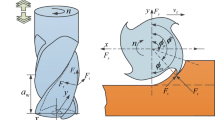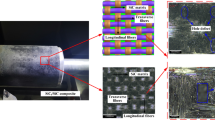Abstract
Carbon-fiber reinforced silicon carbide matrix (C/SiC) composites are typical difficult-to-cut materials due to high hardness and brittleness. Aiming at the problem of the serious tool wear in conventional milling (CM) C/SiC composite process, ultrasonic vibration–assisted milling (UVAM) and conventional milling tests with a diamond-coated milling cutter were conducted. Theoretical and experimental research on the cutting force during the ultrasonic vibration milling process of C/SiC composites is carried out. Based on the kinematics analysis of tool path during ultrasonic vibration milling process, the cutting force model of ultrasonic vibration milling is established, and the influence mechanism of ultrasonic vibration on the cutting force is revealed. Based on the analysis of the evolution law of tool wear profile and wear curve during the traditional milling and ultrasonic vibration milling of C/SiC, the tool wear forms and mechanism of diamond-coated milling cutters in two processing modes and the influence mechanism of ultrasonic vibration on tool wear are revealed. It is found that the main wear mechanism of the diamond-coated milling cutter is abrasive wear, and the main wear form is the coating peeling. Compared with the traditional milling, the tool wear can be reduced by the ultrasonic vibration milling in machining process. In the range of test parameters, the tool wear decreases first and then increases with the increase of ultrasonic amplitude.














Similar content being viewed by others
References
Paulmier T, Balatpichelin M, Le Quéau D (2005) Structural modifications of carbon-carbon composites under high temperature and ion irradiation[J]. Appl Surf Sci 243(1):376–393
Tawakoli T, Azarhoushang B (2011) Intermittent grinding of ceramic matrix composites (CMCs) utilizing a developed segmented wheel[J]. Int J Mach Tool Manu 51(2):112–119
Zhang L, Ren C et al (2016) Effect of fiber orientations on surface grinding process of unidirectional C/SiC composites[J]. Appl Surf Sci 366:424–431
Eneyew ED, Ramulu M (2014) Experimental study of surface quality and damage when drilling unidirectional CFRP composites[J]. J Mater Res Technol 3(4):354–362
Voss R, Seeholzer L, Kuster F et al (2016) Influence of fibre orientation, tool geometry and process parameters on surface quality in milling of CFRP[J]. CIRP J Manuf Sci Technol 18:75–91
Moneim MEA, Abdou S (1997) Comments on the wear mechanisms of impregnated diamond bits[J]. Wear 205(1):228–230
Dhokey NB, Utpat K, Gosavi A et al (2013) Hot-press sintering temperature response of diamond cutting tools and its correlation with wear mechanism[J]. Int J Refract Met Hard Mater 36(1):289–293
Oliveria JFG, Silva EJ, Guo C, Hashimoto F (2009) Industrial challenges in grinding. CIRP J Manuf Sci Technol 58:663–680
Kumar J (2013) Ultrasonic machining—a comprehensive review[J]. Mach Sci Technol 17(3):325–379
Gupta V, Pandey PM (2018) An in-vitro study of cutting force and torque during rotary ultrasonic bone drilling[J]. Proc Inst Mech Eng B J Eng Manuf 232(9):1549–1560
Jain AK, Pandey PM (2016) Experimental studies on tool wear in μ-RUM process[J]. Int J Adv Manuf Technol 85(9–12):1–14
Thirumalai Kumaran S, Ko TJ, Li C et al (2017) Rotary ultrasonic machining of woven CFRP composite in a cryogenic environment[J]. J Alloys Compd 698:984–993
Li C, Zhang F, Meng B et al (2016) Material removal mechanism and grinding force modelling of ultrasonic vibration assisted grinding for SiC ceramics[J]. Ceram Int:43(3)
Azarhoushang B, Tawakoli T (2011) Development of a novel ultrasonic unit for grinding of ceramic matrix composites[J]. Int J Adv Manuf Technol 57(9–12):945–955
Verma GC, Pandey PM, Dixit US (2018) Estimation of workpiece-temperature during ultrasonic-vibration assisted milling considering acoustic softening[J]. Int J Mech Sci 140:547–556
Elhami S, Razfar MR, Farahnakian M (2015) Analytical, numerical and experimental study of cutting force during thermally enhanced ultrasonic assisted milling of hardened AISI 4140[J]. Int J Mech Sci 103:158–171
Riaz M (2013) Hot ultrasonically assisted turning of Ti-15V3Al3Cr3Sn: experimental and numerical analysis[D]. A Doctoral Thesis, Loughborough University,United Kingdom
Sofuoğlu AM, Çakır HF, Gürgen S, Orak S (2018) Experimental investigation of machining characteristics and chatter stability for Hastelloy-X with ultrasonic and hot turning[J], International Journal of Advanced Manufacturing Technology. 95:83–97
Muhammad R, Ahmed N, Demiral M, Roy A, Silberschmidt VV Computational Study of Ultrasonically-Assisted Turning in Ti alloys [J]. Adv Mater Res 223:30–36
Sofuoğlu MA, Çakır HF, Gürgen S, Orak S, Kuşhan MC (2018) Numerical investigation of hot ultrasonic assisted turning of aviation alloys [J]. J Braz Soc Mech Sci Eng 40:122
Gürgen S, Çakır HF, Sofuoğlu AM, Orak S, Kuşhan CM, Li H (2019) Multi-criteria decision-making analysis of different non-traditional machining operations of Ti6Al4V [J]. Soft Comput 23:5259–5272
Sofuoğlu AM, Çakır HF, Ku Şhan CM, Orak S (2019) Optimization of different non-traditional turning processes using soft computing methods [J]. Soft Comput 23:5213–5231
Cakir HF, Gurgen S, Sofuoglu AM, Celik NO, Kushan CM (2015) Finite element modeling of ultrasonic assisted turning of Ti6Al4V alloy [J]. Procedia Soc Behav Sci 195:2839–2848
Gupta V, Pandey PM (2018) An in-vitro study of cutting force and torque during rotary ultrasonic bone drilling[J]. Proc Inst Mech Eng B J Eng Manuf 232(9):1549–1560
Teimouri R, Amini S, Mohagheghian N (2017) Experimental study and empirical analysis on effect of ultrasonic vibration during rotary turning of aluminum 7075 aerospace alloy[J]. J Manuf Process 26:1–12
Peng Y, Liang Z, Wu Y et al (2012) Effect of vibration on surface and tool wear in ultrasonic vibration-assisted scratching of brittle materials[J]. Int J Adv Manuf Technol 59(1–4):67–72
Funding
This work is supported by the National Natural Science Foundation of China (grant no. 51375055)
Author information
Authors and Affiliations
Corresponding author
Additional information
Publisher’s note
Springer Nature remains neutral with regard to jurisdictional claims in published maps and institutional affiliations.
Rights and permissions
About this article
Cite this article
Liu, Y., Liu, Z., Wang, X. et al. Experimental study on tool wear in ultrasonic vibration–assisted milling of C/SiC composites. Int J Adv Manuf Technol 107, 425–436 (2020). https://doi.org/10.1007/s00170-020-05060-z
Received:
Accepted:
Published:
Issue Date:
DOI: https://doi.org/10.1007/s00170-020-05060-z




